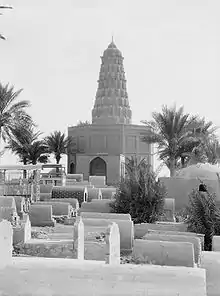| Sayyida Zumurrud Khatun السيدة زمرد خاتون | |||||
|---|---|---|---|---|---|
| Umm walad of the Abbasid caliph | |||||
| Period | 1158 – 1180 | ||||
| Died | December 1202/January or February 1203 Baghdad, Abbasid Caliphate | ||||
| Burial | Sheikh Maarouf Cemetery, Baghdad in Zumurrud Mosque | ||||
| Spouse | Al-Mustadi | ||||
| Children | Ahmad al-Nasir | ||||
| |||||
| Religion | Sunni Islam | ||||
| Occupation |
| ||||
Sayyida Zumurrud Khatun (Arabic: السيدة زمرد خاتون ,died 1203) also known as Umm al-Nasir (Arabic: أم الناصر) was the mother of Abbasid caliph al-Nasir. She was an influential woman of the late 12th-century.
Biography
Zumurrud Khatun[1] was one of Al-Mustadi's concubines. She was a Turkish, and was the mother of the future Caliph al-Nasir.[2]
By most accounts, Zumurrud Khatun is identified as a formerly-enslaved Turkish woman who became a prominent noblewoman during the later Abbasid Caliphate.[3] She rose to this position through marriage to the Caliph al-Mustadi.[3] Zumurrud Khatun is also remembered as the mother of Caliph al-Nasir.[3] She is described as being a religious woman and an active patroness of architecture and public works.[4]
Her legacy as patroness was due to her restoration of public infrastructure and for building educational and funerary buildings.[3] The Mosque and Mausoleum of Zumurrud Khatun were created at the commission of Al-Nasir and his mother before her death in 1202.[1] After her death, she was laid to rest in the mausoleum following a funeral procession.[3]

Zamurrud Khatun was also actively involved in the construction of a madrasa. Furthermore, she was also remembered by many as an active member in politics and Islamic religious policies, a generous person devoted to Islamic teachings and law, and various other aspects.[5] For instance, she is in history for spending 300,000 dirhams to repair water supplies and cisterns during the pilgrimage.[6]
Death
Various chronicles describe Sayyida Zumurrud Khatun as "a very devout woman" who pleaded with her son to free the famous scholar Ibn al-Jawzi. Zumurrud was herself a follower of Hanbali school.
She died in December 1202–January 1203,[7] or January–February 1203,[8] and was buried in her own mausoleum in Sheikh Maarouf Cemetery.[9]
References
- 1 2 Tabbaa, Yasser (2001). The Transformation of Islamic Art during the Sunni Revival. University of Washington Press. ISBN 978-0-295-98125-3.
- ↑ Singer, A. (2002). Constructing Ottoman Beneficence: An Imperial Soup Kitchen in Jerusalem. SUNY series in Near Eastern Studies. State University of New York Press. p. 146. ISBN 978-0-7914-5351-3.
- 1 2 3 4 5 Jacobi, Renate (2012-04-24), "Zumurrud K̲h̲ātūn", Encyclopaedia of Islam, Second Edition, Brill, doi:10.1163/1573-3912_islam_sim_8209, retrieved 2022-11-21
- ↑ El-Hibri, Tayeb (2021-04-22). The Abbasid Caliphate: A History (1 ed.). Cambridge University Press. doi:10.1017/9781316869567.005. ISBN 978-1-316-86956-7.
- ↑ Le Strange, G. (1900). Baghdad during the Abbasid caliphate from contemporary Arabic and Persian sources. Clarendon Press.
- ↑ Leiden (2002). Encyclopedia of Islam. Infobase Publishing.
- ↑ al-Athīr, ʻIzz al-Dīn; Richards, Donald Sydney (2006). Years 589-629/1193-1231. Crusade texts in translation. Ashgate. p. 71. ISBN 978-0-7546-4079-0.
- ↑ Ohlander, Erik (2008). Sufism in an Age of Transition: ʿUmar al-Suhrawardī and the Rise of the Islamic Mystical Brotherhoods. Islamic History and Civilization. Brill. p. 92. ISBN 978-90-474-3214-2.
- ↑ Hann, G.; Dabrowska, K.; Townsend-Greaves, T. (2015). Iraq: The ancient sites and Iraqi Kurdistan. Bradt Travel Guides. Bradt Travel Guides. p. 146. ISBN 978-1-84162-488-4.